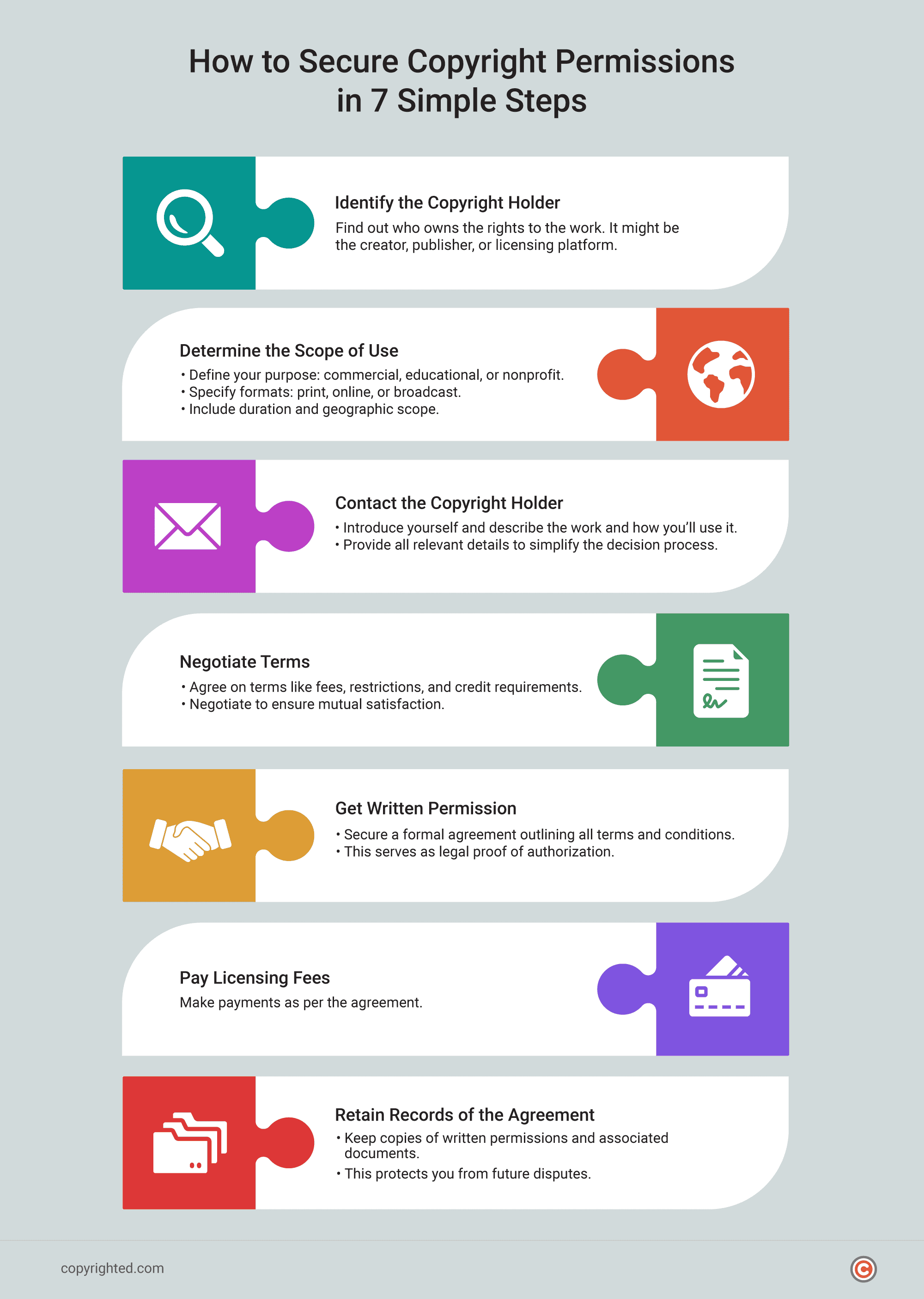Have you ever paused before using a photo, song, or quote, unsure if you’re allowed to? You’re not alone.
Copyright laws often feel complex and leave many wondering what’s permissible. Using someone else’s work without proper permission can result in costly legal issues or damage your reputation, even if done unintentionally.
The good news is that understanding copyright permission doesn’t have to be complicated. This article will explain copyright permission, when you need it, and how to obtain it.
By the end, you’ll know to respect creators’ rights while protecting yourself legally.
- Copyright permission ensures the lawful use of protected works, protecting both the user’s and the creator’s rights.
- Understanding when permission is needed and how to obtain it can prevent legal risks and reputational damage.
- A structured approach, including identifying the copyright holder and negotiating terms, simplifies the permission process.
Table of Contents
What is Copyright Permission?
Copyright permission is the approval a copyright owner grants to use their protected work in a specific way.
According to U.S. copyright law, outlined in 17 U.S.C. § 106, copyright holders have exclusive rights to reproduce, distribute, perform, display, and create derivative works from their original creation.
This means anyone wishing to use a copyrighted work must first obtain permission unless the use falls under exceptions like fair use under 17 U.S. Code § 107.
When you request copyright permission, you ask the creator or rights holder for legal authorization to use their work. This can involve music, images, text, videos, or even software.
Depending on the use, permissions might include licenses for commercial use, public performances, or reproduction in media like books or websites.
Why is Copyright Permission Important?
Obtaining copyright permission is important to ensure your use of someone else’s work is lawful and respectful of their rights. Here’s why it matters:
Avoiding Legal Consequences
Using copyrighted material without permission can result in lawsuits, fines, and criminal charges.
Under 17 U.S.C. § 501, unauthorized use constitutes copyright infringement, and penalties can range from monetary damages to statutory fines of up to $150,000 per infringement.
Respecting Creators’ Rights
Creators hold the exclusive rights to control how their works are used. Seeking permission acknowledges their efforts and ensures their rights are upheld, promoting a culture of creativity and respect.
Protecting Your Reputation
Copyright infringement can damage your credibility and your brand or professional standing. Securing permission demonstrates ethical behavior and a commitment to fair use practices.
Securing Long-Term Use
With proper permission, you gain legal assurance that your use of the material is protected. This is particularly important for businesses, educational content, or creative works that might face scrutiny or extended use.
Expanding Opportunities
Proper licensing or agreements can open doors for collaborations, partnerships, or even monetization of your work involving copyrighted material. Rightsholders are often more willing to work with those who respect their intellectual property.
When Do You Need Copyright Permission?
You need copyright permission whenever you plan to use a work with copyright protection in a way that falls under the copyright holder’s exclusive rights.
Certain exceptions, such as fair use, works in the public domain, and Creative Commons licenses, may allow limited use without explicit permission. However, these situations should be carefully evaluated to ensure compliance with the law.
Below are common scenarios where permission is required:
- Reproducing the Work: If you want to copy or duplicate a copyrighted work, such as making a photocopy of a book or downloading an image for your website, you need the rights holder’s approval. This includes both physical and digital reproductions.
- Distributing Copies: Distributing copyrighted material, whether through sales, free sharing, or digital uploads. This applies to ebooks, software, movies, and other content.
- Public Performances or Displays: Performing or displaying copyrighted works in public, like playing music at an event, screening a movie, or showing an art piece in a gallery.
- Creating Derivative Works: Modifying or building upon a copyrighted work, such as turning a novel into a screenplay or remixing a song, constitutes creating a derivative work. According to the U.S. Copyright Office, you must obtain the creator’s consent for this.
- Commercial Use: Using copyrighted material for commercial purposes, like advertising, merchandise, or paid content. Even if the use seems minor, commercial implications heighten the need for legal authorization.
- Educational or Nonprofit Use Outside of Fair Use: While some use in educational or nonprofit settings may qualify for the fair use exception, many do not. For instance, using an entire copyrighted work or distributing copies to a class.
- Online or Digital Uses: Uploading copyrighted content to social media, blogs, or websites can infringe copyright, especially if it involves music, images, or videos. Platforms may enforce takedowns if permission is not secured.
- Translations: Translating a book, article, or other creative work into another language is considered a derivative work, requiring permission.
How to Get Permission to Copyright
Getting copyright permission involves contacting the copyright holder and obtaining their explicit approval to use their work.
Follow the steps below to ensure a smooth and lawful process.

1. Identify the Copyright Holder
The copyright holder is often the work’s creator, but rights may also be owned by publishers, agencies, or estates. For example:
- For books, check the publisher.
- For music, contact the record label or performing rights organization.
- For images or artwork, the creator or licensing platforms may hold the rights.
2. Determine the Scope of Use
Clearly define how you plan to use the copyrighted work. Be specific about:
- The types of use are commercial, educational, and nonprofit.
- The format includes print, online, and broadcast.
- The duration of use, such as one-time and ongoing.
- The geographic area is local and global.
Providing these details will help the rights holder determine the terms of permission.
3. Contact the Copyright Holder
To obtain permission, contact the copyright holder directly or through their representative. In your request, briefly introduce yourself, clearly describe the work you want to use, and explain how you intend to use and distribute it.
Include relevant details, such as the target audience or the platform where the work will appear, to ensure the copyright holder has all the necessary information.
4. Negotiate Terms
If the copyright holder agrees to your request, they may outline specific terms, such as licensing fees or royalties, restrictions on use, and credit or attribution requirements. Negotiate if necessary to reach a mutually acceptable agreement.
5. Get Written Permission
Always obtain written permission, even if the copyright holder verbally agrees.
A formal agreement or license should include the scope of use, the duration and terms of the agreement, and any conditions or limitations. This serves as legal proof of authorization.
6. Pay Licensing Fees (If Required)
Depending on the work and its intended use, the copyright holder may charge a fee for granting permission. Payments should be made as per the agreement.
7. Retain Records of the Agreement
Keep a copy of the written permission and any associated documents for your records. This can protect you in case of future disputes or claims of infringement.
Frequently Asked Questions
Do you always need permission to use copyrighted material?
No, you don’t always need permission; exceptions include fair use, public domain works, and certain Creative Commons licenses.
Who can grant copyright permission?
Only the copyright holder, which could be the creator or a designated rights holder, can grant permission.
Do you have to pay for copyright permission?
Not always. Some permissions may be free, but others might involve licensing fees or royalties.
Can copyright permission be revoked?
Yes, it can be revoked if stipulated in the agreement or if terms are breached.
What’s the difference between a license and copyright permission?
A license is a formal agreement outlining specific terms of use, while copyright permission is a broader authorization that may or may not include detailed terms.


